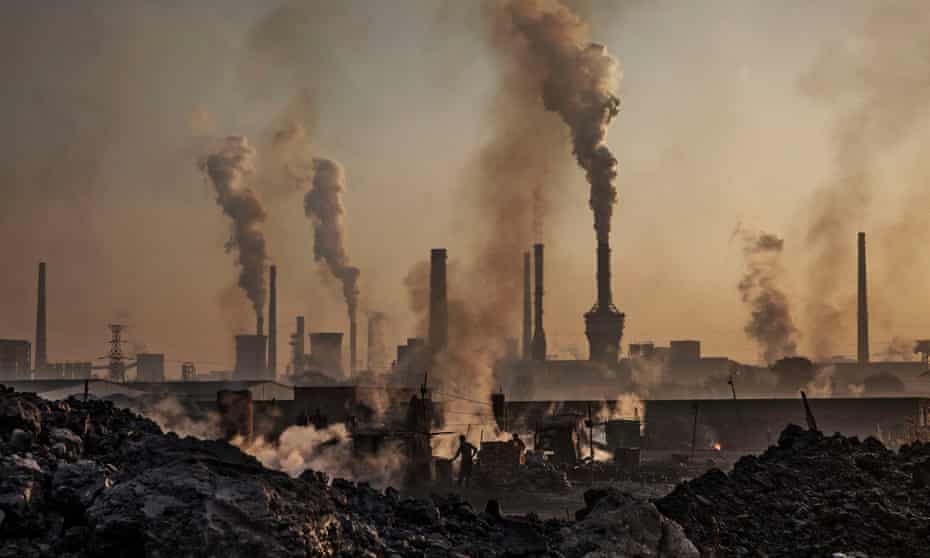‘Reality check’: Global CO2 emissions shooting back to record levels
Fossil fuels are surging in post-pandemic recovery as scientists warn 1.5C emission limits will be reached in 11 years

Global carbon emissions are shooting back to the record level seen before the coronavirus pandemic levels, new analysis has shown. Scientists said the finding is a “reality check” for the world’s nations gathered at the Cop26 climate summit.
The emissions driving the climate crisis reached their highest ever levels in 2019, before global coronavirus lockdowns saw them fall by 5.4%. However, fossil fuel burning has surged faster than expected in 2021, the international research team said, in stark contrast to the rapid cuts needed to tackle global heating.
The data shows world leaders have failed to build back greener, with just a small proportion of pandemic spending going to sustainable sectors. But the scientists said hopes of keeping global heating to 1.5C remain alive if Cop26 leads to rapid global action.
The Global Carbon Project (GCP) report shows emissions from coal and gas jumping this year by more than they fell in 2020. Oil use is also rising in 2021, but more slowly because transport activity remains below normal.
Unlike most countries, emissions in the world’s biggest polluter, China, actually rose slightly during the pandemic in 2020 and are expected to rise another 4% in 2021. India has very low emissions per person but will see CO2 rise 12.6% in 2021, almost double the fall in 2020.
The US and EU27 will also see sharp rises of 7.6% in 2021, but remain on a longer term trend of slowly declining emissions. Renewables were the only energy source that continued to grow during the pandemic.
The scientists said 2022 could set a new record for global emissions, depending on whether the expected increased in oil consumption, as travel recovers further, is offset by reversal of the surge in coal burning seen in 2021.
The world’s “carbon budget” is the total emissions allowed to retain a 50% chance of keeping global temperature rise below 1.5C, but analysis shows this will be blown in 11 years if the current rate of emissions continues.
“What is surprising is that [the rebound in emissions] happened so quickly, in spite of the fact that much of the global economy has not yet recovered,” said Prof Corinne Le Quere, at the University of East Anglia, UK, and one of the analysis team. “This is really a reality check.”
“However, we do not yet see the effect of the climate policy decisions that will be taken at Cop26 in Glasgow, which could be really a gamechanger,” she said. “1.5C is still alive. The decrease in emissions needed is very large indeed, but feasible with concerted action.”
Glen Peters, at the Centre for International Climate Research in Oslo, Norway, said: “Many of us were [expecting] a recovery spread out over a few years, as opposed to a big hit in 2021.” He said Covid recovery funding had been too “dirty”, with not enough low-carbon investment. “If we continue on the current trajectory, then that may push emissions in 2022 up.”
Prof Pierre Friedlingstein, at the University of Exeter, UK, said: “To achieve net zero by 2050, we must cut emissions every year by an amount comparable to that seen during Covid. This highlights the scale of the action that is now required, and the importance of Cop26.”
The 196 nations at the Cop26 summit are charged with pushing national pledges to cut emissions towards that needed for 1.5C, with India’s new commitment to net zero a notable advance. But the $100bn promised by rich nations to poorer nations has yet to be delivered. Voluntary international pacts to end deforestation, cut methane emissions and make green technology the cheapest option have been announced. But global heating will only stop when emissions reach net zero.
The GCP report was produced by almost 100 scientists from 70 organisations across the world and, based on the figures to date, calculated that CO2 emissions from fossil fuels will rise by between 4.1% and 5.7% in 2021, compared with a fall of 5.4% in 2020. That fall is bigger than seen after the global financial crisis in 2008 (1.2%) and the collapse of the Soviet Union (3.1%).
Emissions will have to be reduced by even greater amounts to hit net zero by 2050. But Le Quere said: “We know what to do: move out of coal, electrify transport, and reforest.” She said a quarter of emissions come from countries that had been steadily decreasing emissions while growing their economies, including the UK, Germany, the US, Japan and Mexico.
“The key message is to resist the temptation to be discouraged by our latest findings,” she said. “The commitments being put in place at Cop26 are really important. It’s important that the countries agree on what they’re going to do and then, of course, plan for immediate implementation.”
The surge in emissions in 2021 resulted from Covid recovery packages largely funding existing, polluting industries including steel, cement and construction, particularly in China, Peters said: “China is, on the one hand, making extremely good progress, deploying solar and wind and electric vehicles. On the other hand, its economic recovery packages tend to go back to the old way of doing things. But there’s another 70% of global emissions that are not from China as well.”
Whether 2022 sees a new record for global emissions depends on whether the burst of coal burning seen during the pandemic recovery was a temporary “sugar hit” or continues, he said.
